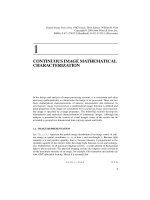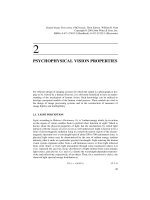Tài liệu Xử lý hình ảnh kỹ thuật số P2 pdf
Bạn đang xem bản rút gọn của tài liệu. Xem và tải ngay bản đầy đủ của tài liệu tại đây (349.68 KB, 22 trang )
23
2
PSYCHOPHYSICAL VISION PROPERTIES
For efficient design of imaging systems for which the output is a photograph or dis-
play to be viewed by a human observer, it is obviously beneficial to have an under-
standing of the mechanism of human vision. Such knowledge can be utilized to
develop conceptual models of the human visual process. These models are vital in
the design of image processing systems and in the construction of measures of
image fidelity and intelligibility.
2.1. LIGHT PERCEPTION
Light, according to Webster's Dictionary (1), is “radiant energy which, by its action
on the organs of vision, enables them to perform their function of sight.” Much is
known about the physical properties of light, but the mechanisms by which light
interacts with the organs of vision is not as well understood. Light is known to be a
form of electromagnetic radiation lying in a relatively narrow region of the electro-
magnetic spectrum over a wavelength band of about 350 to 780 nanometers (nm). A
physical light source may be characterized by the rate of radiant energy (radiant
intensity) that it emits at a particular spectral wavelength. Light entering the human
visual system originates either from a self-luminous source or from light reflected
from some object or from light transmitted through some translucent object. Let
represent the spectral energy distribution of light emitted from some primary
light source, and also let and denote the wavelength-dependent transmis-
sivity and reflectivity, respectively, of an object. Then, for a transmissive object, the
observed light spectral energy distribution is
(2.1-1)
E λ()
t λ() r λ()
C λ() t λ()E λ()=
Digital Image Processing: PIKS Inside, Third Edition. William K. Pratt
Copyright © 2001 John Wiley & Sons, Inc.
ISBNs: 0-471-37407-5 (Hardback); 0-471-22132-5 (Electronic)
24
PSYCHOPHYSICAL VISION PROPERTIES
and for a reflective object
(2.1-2)
Figure 2.1-1 shows plots of the spectral energy distribution of several common
sources of light encountered in imaging systems: sunlight, a tungsten lamp, a
FIGURE 2.1-1. Spectral energy distributions of common physical light sources.
C λ() r λ()E λ()=
LIGHT PERCEPTION
25
light-emitting diode, a mercury arc lamp, and a helium–neon laser (2). A human
being viewing each of the light sources will perceive the sources differently. Sun-
light appears as an extremely bright yellowish-white light, while the tungsten light
bulb appears less bright and somewhat yellowish. The light-emitting diode appears
to be a dim green; the mercury arc light is a highly bright bluish-white light; and the
laser produces an extremely bright and pure red beam. These observations provoke
many questions. What are the attributes of the light sources that cause them to be
perceived differently? Is the spectral energy distribution sufficient to explain the dif-
ferences in perception? If not, what are adequate descriptors of visual perception?
As will be seen, answers to these questions are only partially available.
There are three common perceptual descriptors of a light sensation: brightness,
hue, and saturation. The characteristics of these descriptors are considered below.
If two light sources with the same spectral shape are observed, the source of
greater physical intensity will generally appear to be perceptually brighter. How-
ever, there are numerous examples in which an object of uniform intensity appears
not to be of uniform brightness. Therefore, intensity is not an adequate quantitative
measure of brightness.
The attribute of light that distinguishes a red light from a green light or a yellow
light, for example, is called the hue of the light. A prism and slit arrangement
(Figure 2.1-2) can produce narrowband wavelength light of varying color. However,
it is clear that the light wavelength is not an adequate measure of color because
some colored lights encountered in nature are not contained in the rainbow of light
produced by a prism. For example, purple light is absent. Purple light can be
produced by combining equal amounts of red and blue narrowband lights. Other
counterexamples exist. If two light sources with the same spectral energy distribu-
tion are observed under identical conditions, they will appear to possess the same
hue. However, it is possible to have two light sources with different spectral energy
distributions that are perceived identically. Such lights are called metameric pairs.
The third perceptual descriptor of a colored light is its saturation, the attribute
that distinguishes a spectral light from a pastel light of the same hue. In effect, satu-
ration describes the whiteness of a light source. Although it is possible to speak of
the percentage saturation of a color referenced to a spectral color on a chromaticity
diagram of the type shown in Figure 3.3-3, saturation is not usually considered to be
a quantitative measure.
FIGURE 2.1-2. Refraction of light from a prism.
26
PSYCHOPHYSICAL VISION PROPERTIES
As an aid to classifying colors, it is convenient to regard colors as being points in
some color solid, as shown in Figure 2.1-3. The Munsell system of color
classification actually has a form similar in shape to this figure (3). However, to be
quantitatively useful, a color solid should possess metric significance. That is, a unit
distance within the color solid should represent a constant perceptual color
difference regardless of the particular pair of colors considered. The subject of
perceptually significant color solids is considered later.
2.2. EYE PHYSIOLOGY
A conceptual technique for the establishment of a model of the human visual system
would be to perform a physiological analysis of the eye, the nerve paths to the brain,
and those parts of the brain involved in visual perception. Such a task, of course, is
presently beyond human abilities because of the large number of infinitesimally
small elements in the visual chain. However, much has been learned from physio-
logical studies of the eye that is helpful in the development of visual models (4–7).
FIGURE 2.1-3. Perceptual representation of light.
EYE PHYSIOLOGY
27
Figure 2.2-1 shows the horizontal cross section of a human eyeball. The front
of the eye is covered by a transparent surface called the cornea. The remaining outer
cover, called the sclera, is composed of a fibrous coat that surrounds the choroid, a
layer containing blood capillaries. Inside the choroid is the retina, which is com-
posed of two types of receptors: rods and cones. Nerves connecting to the retina
leave the eyeball through the optic nerve bundle. Light entering the cornea is
focused on the retina surface by a lens that changes shape under muscular control to
FIGURE 2.2-1. Eye cross section.
FIGURE 2.2-2. Sensitivity of rods and cones based on measurements by Wald.
28
PSYCHOPHYSICAL VISION PROPERTIES
perform proper focusing of near and distant objects. An iris acts as a diaphram to
control the amount of light entering the eye.
The rods in the retina are long slender receptors; the cones are generally shorter and
thicker in structure. There are also important operational distinctions. The rods are
more sensitive than the cones to light. At low levels of illumination, the rods provide a
visual response called scotopic vision. Cones respond to higher levels of illumination;
their response is called photopic vision. Figure 2.2-2 illustrates the relative sensitivities
of rods and cones as a function of illumination wavelength (7,8). An eye contains
about 6.5 million cones and 100 million cones distributed over the retina (4). Figure
2.2-3 shows the distribution of rods and cones over a horizontal line on the retina
(4). At a point near the optic nerve called the fovea, the density of cones is greatest.
This is the region of sharpest photopic vision. There are no rods or cones in the vicin-
ity of the optic nerve, and hence the eye has a blind spot in this region.
FIGURE 2.2-3. Distribution of rods and cones on the retina.
VISUAL PHENOMENA
29
In recent years, it has been determined experimentally that there are three basic
types of cones in the retina (9, 10). These cones have different absorption character-
istics as a function of wavelength with peak absorptions in the red, green, and blue
regions of the optical spectrum. Figure 2.2-4 shows curves of the measured spectral
absorption of pigments in the retina for a particular subject (10). Two major points
of note regarding the curves are that the cones, which are primarily responsible
for blue light perception, have relatively low sensitivity, and the absorption curves
overlap considerably. The existence of the three types of cones provides a physio-
logical basis for the trichromatic theory of color vision.
When a light stimulus activates a rod or cone, a photochemical transition occurs,
producing a nerve impulse. The manner in which nerve impulses propagate through
the visual system is presently not well established. It is known that the optic nerve
bundle contains on the order of 800,000 nerve fibers. Because there are over
100,000,000 receptors in the retina, it is obvious that in many regions of the retina,
the rods and cones must be interconnected to nerve fibers on a many-to-one basis.
Because neither the photochemistry of the retina nor the propagation of nerve
impulses within the eye is well understood, a deterministic characterization of the
visual process is unavailable. One must be satisfied with the establishment of mod-
els that characterize, and hopefully predict, human visual response. The following
section describes several visual phenomena that should be considered in the model-
ing of the human visual process.
2.3. VISUAL PHENOMENA
The visual phenomena described below are interrelated, in some cases only mini-
mally, but in others, to a very large extent. For simplification in presentation and, in
some instances, lack of knowledge, the phenomena are considered disjoint.
FIGURE 2.2-4. Typical spectral absorption curves of pigments of the retina.
α
30
PSYCHOPHYSICAL VISION PROPERTIES
.
Contrast Sensitivity. The response of the eye to changes in the intensity of illumina-
tion is known to be nonlinear. Consider a patch of light of intensity surrounded
by a background of intensity I (Figure 2.3-1a). The just noticeable difference is to
be determined as a function of I. Over a wide range of intensities, it is found that the
ratio , called the Weber fraction, is nearly constant at a value of about 0.02
(11; 12, p. 62). This result does not hold at very low or very high intensities, as illus-
trated by Figure 2.3-1a (13). Furthermore, contrast sensitivity is dependent on the
intensity of the surround. Consider the experiment of Figure 2.3-1b, in which two
patches of light, one of intensity I and the other of intensity , are sur-
rounded by light of intensity . The Weber fraction for this experiment is
plotted in Figure 2.3-1b as a function of the intensity of the background. In this
situation it is found that the range over which the Weber fraction remains constant is
reduced considerably compared to the experiment of Figure 2.3-1a. The envelope of
the lower limits of the curves of Figure 2.3-lb is equivalent to the curve of Figure
2.3-1a. However, the range over which is approximately constant for a fixed
background intensity is still comparable to the dynamic range of most electronic
imaging systems.
FIGURE 2.3-1. Contrast sensitivity measurements.
(
a
) No background
(
b
) With background
I ∆I+
∆I
∆II⁄
I ∆I+
I
o
∆II⁄
∆II⁄
I
o









